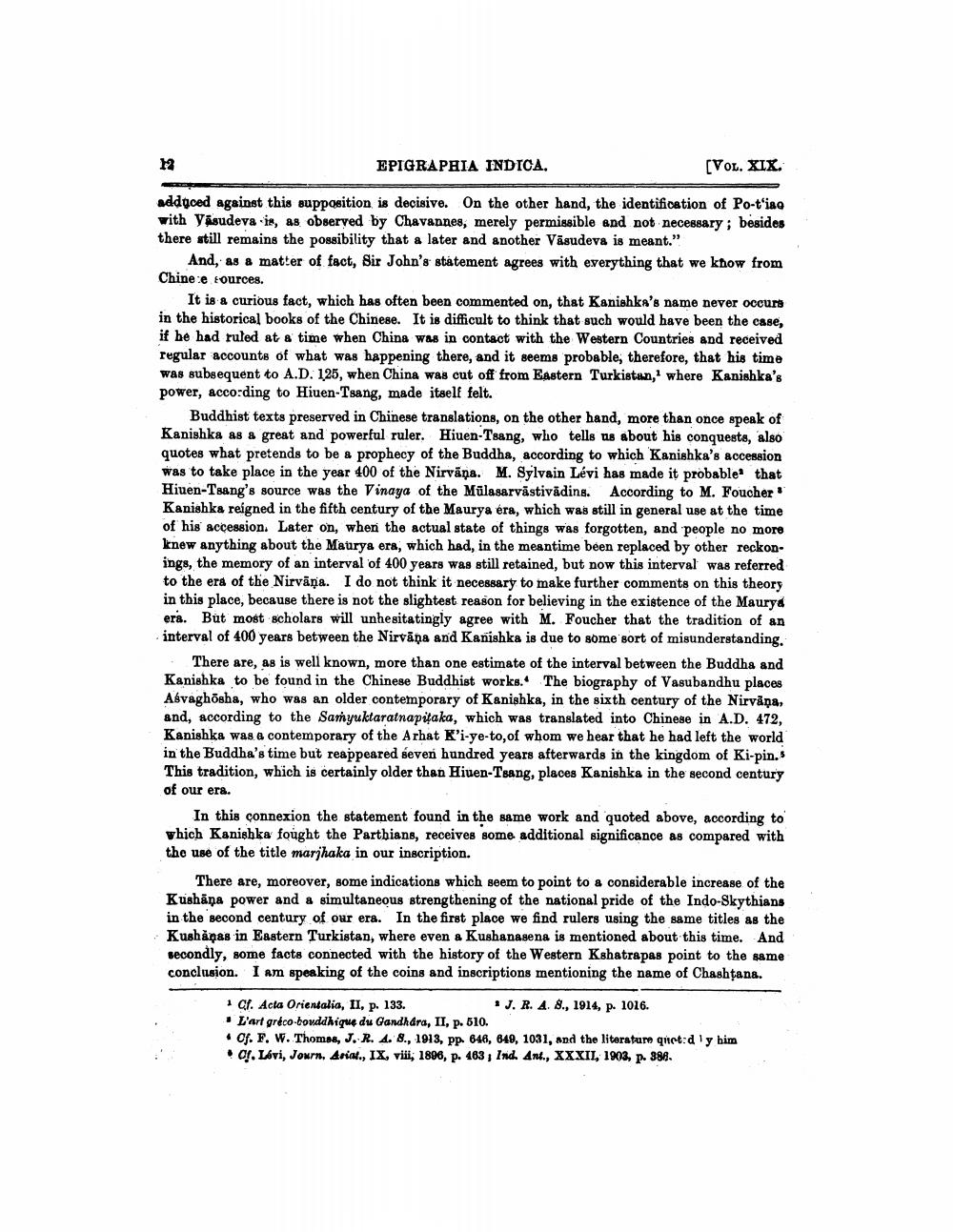________________
12
EPIGRAPHIA INDICA,
(VOL. XIX.
adduced against this supposition is decisive. On the other hand, the identification of Po-t'iae with Vasudeva is, as observed by Chavannes, merely permissible and not necessary; besides there still remains the possibility that a later and another Väsudeva is meant.”
And, as a matter of fact, Sir John's statement agrees with everything that we know from Chine e sources.
It is a curious fact, which has often been commented on, that Kanishka's name never occurs in the historical books of the Chinese. It is difficult to think that such would have been the case, if he had ruled at a time when China was in contact with the Western Countries and received regular accounts of what was happening there, and it seems probable, therefore, that his time was subsequent to A.D. 125, when China was cut off from Eastern Turkistan,' where Kanishka's power, according to Hiuen-Tsang, made itself felt.
Buddhist texts preserved in Chinese translations, on the other hand, more than once speak of Kanishka as a great and powerful ruler. Hiuen-Tsang, who tells us about his conquests, also quotes what pretends to be a prophecy of the Buddha, according to which Kanishka's accession was to take place in the year 400 of the Nirvāņa. M. Sylvain Lévi has made it probable that Hiuen-Tsang's source was the Vinaya of the Mūlasarvāstivāding. According to M. Foucher Kanishka reigned in the fifth century of the Maurya éra, which was still in general use at the time of his accession. Later on, when the actual state of things was forgotten, and people no more knew anything about the Maurya era, which had, in the meantime been replaced by other reckonings, the memory of an interval of 400 years was still retained, but now this interval was referred to the era of the Nirvāņa. I do not think it necessary to make further comments on this theory in this place, because there is not the slightest reason for believing in the existence of the Maurya era. But most scholars will unhesitatingly agree with M. Foucher that the tradition of an interval of 400 years between the Nirvana and Kanishka is due to some sort of misunderstanding.
There are, as is well known, more than one estimate of the interval between the Buddha and Kanishka to be found in the Chinese Buddhist works. The biography of Vasubandhu places Asvaghosha, who was an older contemporary of Kanishka, in the sixth century of the Nirvåņa, and, according to the Samyuktaratnapitaka, which was translated into Chinese in A.D. 472, Kanishka was a contemporary of the Arhat K'i-ye-to, of whom we hear that he had left the world in the Buddha's time but reappeared seven hundred years afterwards in the kingdom of Ki-pin. This tradition, which is certainly older than Hiuen-Tsang, places Kanishka in the second century of our era.
In this connexion the statement found in the same work and quoted above, according to which Kanishka fought the Parthians, receives some additional significance as compared with the use of the title marjhaka in our inscription.
There are, moreover, some indications which seem to point to a considerable increase of the Kushāņa power and a simultaneous strengthening of the national pride of the Indo-Skythians in the second century of our era. In the first place we find rulers using the same titles as the Kushåpas in Eastern Turkistan, where even a Kushanasena is mentioned about this time. And secondly, some facts connected with the history of the Western Kshatrapas point to the same conclusion. I am speaking of the coins and inscriptions mentioning the name of Chashtana.
1 Cf. Acta Orientalia, II, p. 133.
J. R. A. 8., 1914, p. 1016. L'art gréco-bouddhique du Gandhdra, II, p. 510. . Cf. F. W. Thomas, J. R. 4. 8., 1913, pp. 646, 640, 1031, and the literaturo quet:d ly him .of. Lovi, Journ, Ariat., IX, viii, 1896, p. 463, Indh. Ant., XXXII, 1903, p. 388.




